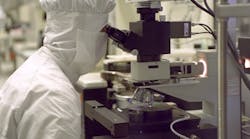The advantages of gallium-nitride (GaN) in high-frequency RF devices have been widely documented, but gallium-arsenide (GaA) has remained a major part of wireless infrastructure and military RF systems. GaAs Labs, an investment firm based in Silicon Valley that has turned its eyes toward RF semiconductors, has agreed to purchase Anadigics and its GaA production facility for approximately $32 million.
Since 1988, Anadigics has focused on the design and manufacturing of GaA compound semiconductors, although it has branched out into indium gallium-phosphide (InGaP) and GaN technologies. The company is involved primarily in the commercial RF market, including mobile communications, infrastructure, community antenna television (CATV), small-cell, Wi-Fi, and optical. It offers a wide range of reverse-path amplifiers, power amplifiers, line amplifiers, and front-ends.
Anadigics maintains a 6-in. GaA wafer fabrication plant in Warren, N.J., where it produces InGaP HBT, GaAs MESFET, and GaAs pHEMT products. The company has invented a patented InGaP process, which integrates bipolar and FET structures, combining the power-amplifier function and RF active-switch function on the same die. Despite its central focus on GaA products, the company has begun to add GaN devices and components to their product line.
For its part, GaAs Labs has purchased several commercial RF chipmakers over the last few years. The firm was established by John Ocampo, one of the founders of Sirenza Microdevices. GaAs Labs acquired the commercial segment of MA/COM Technology Solutions from aerospace company Cobham in 2009. Three years later, it purchased Nitronex Corp., a company that designs and manufactures GaN RF products for defense, communications, cable TV, and industrial and scientific markets.
The transaction comes as the market for commercial RF components remains on a steady path. To keep pace with an explosion of mobile data traffic, service providers have continued to invest in wireless infrastructure, resulting in higher demand for RF power amplifiers and other devices. In spite of plans to introduce more efficient and lower-cost networks, companies are expanding their installed base of cellular stations, small cells, and wireless access points.
GaAs have been a central component of microwave and RF devices for decades and are expected to remain so for several more years. Despite concerns that GaN is starting to displace GaAs in certain devices, analysts predict that the market for GaAs will hit its peak at over $8 billion in 2018, according to a recent report from the research firm Strategy Analytics.
Wireless communications devices and cellular terminals still rely significantly on GaAs, in spite of GaN’s gradual shift out of military and into commercial applications. Asif Anwar, director in the strategic technologies practice at Strategy Analytics, adds that defense systems’ “particular communications and EW applications still rely on the performance of GaAs devices.”
GaN devices have not advanced as quickly as industry analysts had expected, and there are still significant hurdles to the widespread usage of the technology. Cost reduction and more efficient manufacturing methods remain the highest priorities as GaN attempts to muscle into markets dominated by LDMOS and GaA technology. In preparation for the rapid growth anticipated for GaN, all of the companies under the GaAs Labs mantle have begun to introduce GaN power amplifiers and other devices.
The transaction came as Anadigics reported significant losses in the third quarter of 2015. In October, Anadigics’ stock price fell to $0.21, its lowest point since the company’s initial public offering. GaAs Labs agreed to pay $0.35 per share, which represented a premium of almost 40% over the stock price earlier this month.
